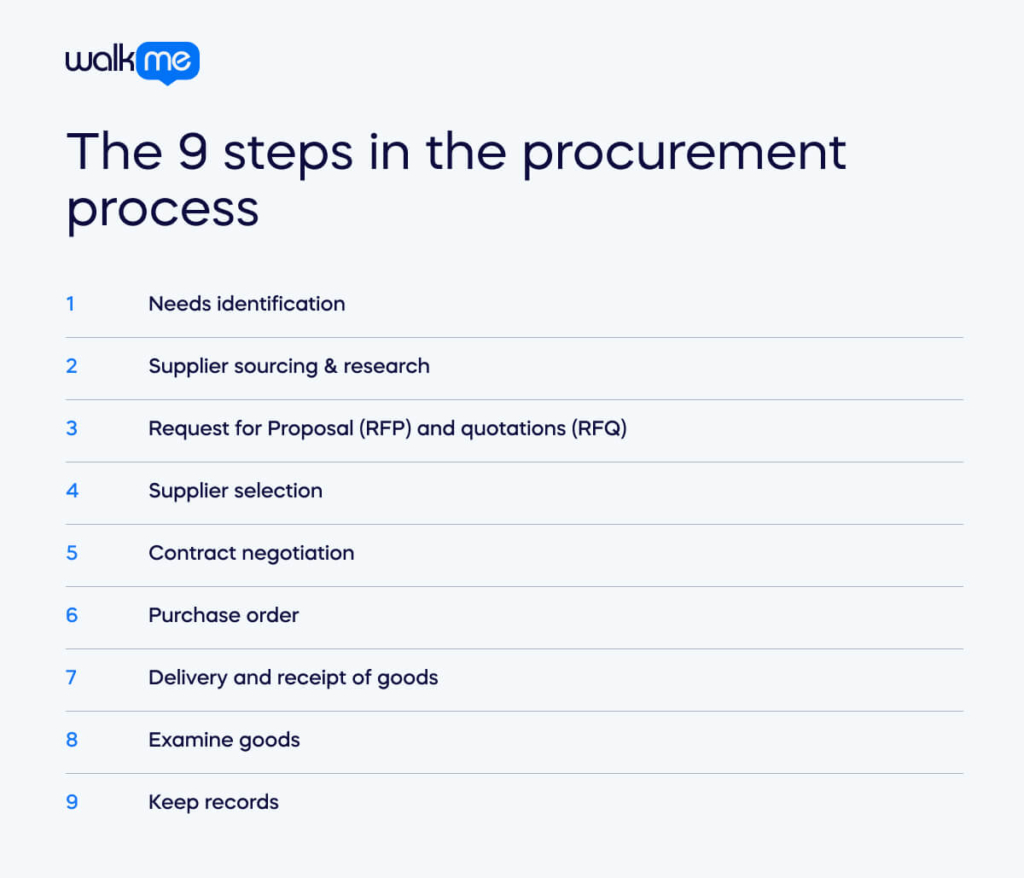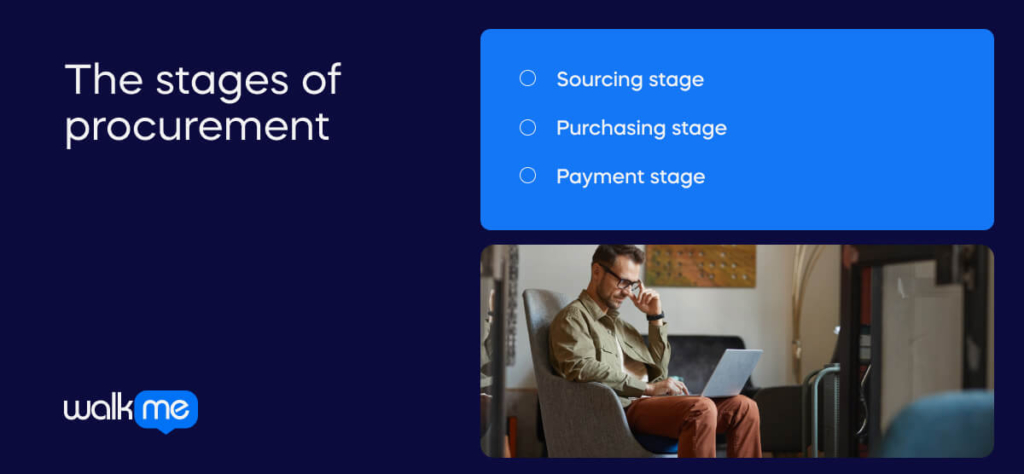The buying and selling of goods and services have long been essential to how we function as a society. The exchange of resources has helped fast-track innovation and the creation of new inventions throughout history.
This enabled the birth of business, where these transactions eventually led to sophisticated forms of trade and commerce.
For today’s businesses, this has evolved into the procurement process. It’s essentially a roadmap that guides how businesses buy things from start to finish.
This article will help readers navigate the world of procurement. We’ll dissect the process, explore its key steps, and explore the various procurement types and stages.
The aim is to help today’s future-ready firms to optimize procurement management practices. An efficient procurement process ensures businesses gain the most value from every purchase.
What is the procurement process?
Put simply—procurement describes purchasing and acquiring goods and services. This is typically emphasized in a business context, where the swift flow of resources is relied on to operate.
The procurement process involves buying physical resources such as precious metals or semiconductors for computer manufacturers. It could also include buying intangible cloud services like those from today’s top SaaS providers.
For businesses with complex operations, procurement becomes synonymous with a well-defined process. This process encompasses a more concrete sequence of steps and activities. It usually begins with preparation, moves through vendor management, and ends with contract finalization and delivery.
Procurement can differ for every business, with some viewing it as a simple one-time purchase. In this context, we’ll explore it as a step-by-step process, ensuring a more strategic approach to this critical business function.
What are the 9 steps in the procurement process?

Now that we understand the procurement process, let’s break it down into critical steps.
According to a report by Verified Market Research, the global procurement software market is exploding, with projections to reach $9.5 billion by 2028.
This presents a significant opportunity for businesses. Understanding these steps will help them make the most of their procurement technology investments
1. Needs identification
Needs identification is the cornerstone of successful procurement. It is a critical step toward maximizing efficiency and minimizing costly resource mismatches.
It involves a strategic and in-depth analysis of the products or services. This is essential for your business to thrive, prioritizing core needs over simple desires.
Define these needs meticulously. Specify quantities, quality requirements, technical specifications, delivery timelines, budget constraints, and other relevant criteria.
This targeted approach ensures you acquire the right resources at the best price. It also lays the groundwork for smoother negotiations and clearer supplier communication. This leads to timely fulfillment and an overall streamlined process.
As a result, you save time and protect your business against potential disruptions.
2. Supplier sourcing & research
Supplier sourcing and research are crucial steps in finding the right partners for your business.
Start by determining the specific products or services you need and the quality standards they must meet. Thorough research is key. Investigate potential suppliers’ capabilities, delivery timelines, pricing structures, and overall reliability.
To make informed decisions, consider industry reputation, customer reviews, and financial stability. A fully rounded sourcing and research process ensures you secure suppliers who align with your operational needs, budget, and quality standards. This helps reduce risk and optimize supply chain management.
3. Request for Proposal (RFP) and quotations (RFQ)
The Request for Proposal (RFP) and Request for Quotation (RFQ) are essential procurement tools. Understanding their differences is key to making the best supplier choices.
An RFP is a detailed project outline that goes beyond just price. It delves into supplier capabilities and methodologies. It does this by exploring how they would tackle your unique needs. RFPs are best suited for situations with complex requirements. Or when you want to compare innovative solutions from potential vendors.
RFQs focus on the bottom line. You already know exactly what you need. Now it’s time to find the best price for that specific good or service. RFQs are ideal for standardized products or services where cost is the primary deciding factor.
Choosing the right tool depends on your specific needs. Use an RFP for complex projects, evaluating innovative solutions, or when quality and methodology are as important as price.
You can also use an RFQ for standard items, repeat purchases, or when price is the main factor in your decision.
4. Supplier selection
Selecting the best supplier isn’t just about finding the rock-bottom price. Several factors deserve your consideration when making this crucial decision.
First and foremost, ensure the supplier truly understands your needs and has the capabilities to deliver. This includes having the products or services, and the expertise to fulfill your requirements. Consistent quality is paramount.
You need a supplier you can rely on to deliver products or services that consistently meet your expectations. Do this to avoid disruptions to your own operations. Reliability is equally important. Reliable suppliers ensure your business runs smoothly. They do this by consistently meeting deadlines and delivering on time.
Don’t overlook financial stability. A financially healthy supplier is essential for a long-term partnership. A secure supplier is less likely to face disruptions that could impact your business down the line.
Finally, clear and open communication is key. A strong relationship with your supplier hinges on openly discussing questions, concerns, and potential changes. Are they responsive and easy to work with? Considering these factors will help you make objective, data-driven decisions.
Creating a scorecard that weighs these priorities can be valuable for comparing potential suppliers.
5. Contract negotiation
Contract negotiation is a crucial stage. It’s where you and your chosen supplier work together to finalize the terms of your agreement. It’s a balancing act that protects your interests while fostering a beneficial relationship that sets the stage for a successful long-term partnership.
During this negotiation, several key areas deserve focus. Negotiating a fair price that reflects the value you receive and aligns with your budget is essential. It is also crucial to ensure clear timelines for delivery that meet your needs and avoid potential disruptions.
Additionally, it is vital to establish clear quality standards and how the supplier will ensure they are met. Warranty terms that provide adequate protection in case of product or service deficiencies should also be negotiated. It is important to secure favorable payment terms that manage your cash flow effectively.
Clearly defining a process for resolving any disagreements during the contract’s lifespan is essential.
Don’t be afraid to negotiate the most advantageous terms for your business. Remember, a well-negotiated contract minimizes future risks. It does the hard work and lays the groundwork for a successful partnership. Consider involving a legal expert when dealing with complex legal or financial clauses. They can help ensure everything is covered comprehensively.
6. Purchase order
A purchase order (PO) is the official confirmation of your purchase. It’s a legally binding document that clearly outlines the details of the agreement, safeguarding both your company and the supplier.
To ensure a clear and accurate PO, include the following information:
The PO should include your company’s name, address, contact information, and supplier’s. Assign a unique PO number for easy tracking purposes. Include the date the order is placed and the requested delivery date.
Provide detailed descriptions of each item, including SKUs or product codes if applicable. This ensures everyone involved understands exactly what’s being purchased. Specify the quantity of each item ordered.
List each item’s unit price and total cost, clearly separating the purchase amount. Outline the shipping terms, including how the goods will be delivered and any associated fees. Clearly define the payment terms. For example, net 30 specifies payment within 30 days to establish clear expectations for payment.
Remember, a well-crafted PO is essential. Double-check everything thoroughly before sending it to the supplier to avoid any misunderstandings.
7. Delivery and receipt of goods
The delivery and receipt of goods mark the exciting culmination of the procurement process. To ensure a smooth handover, here are some key actions to take:
Close collaboration with your supplier is essential throughout the delivery process. Discuss expectations, confirm the delivery address, and address any time restrictions. Ensure all this information aligns with the terms outlined in your contract for a seamless experience.
Upon receipt, a meticulous inspection of the goods against the purchase order and shipping documents is crucial. Check for discrepancies, damage, or missing items. If you find any issues, meticulously document everything with photos or videos as necessary. This documented evidence will be crucial for resolving any discrepancies.
Once everything is confirmed as accurate and complete, have an authorized person sign the delivery receipt. Keep a copy of this signed document for your records. This serves as official verification that the goods were received in good condition.
If you encounter any problems with the delivery, such as missing items or damaged goods, contact your supplier immediately. Refer to your contract to identify the agreed-upon process for handling such situations. By following the established procedures, you can ensure a swift resolution.
8. Examine goods
Examining goods upon receipt is more than just a formality. It’s your final defense against costly errors, potential delays, and even quality issues that could damage your business reputation. Think of it as a quality control checkpoint. It verifies that the promises outlined in your purchase order match the reality delivered to your doorstep.
Maturity is key to making this step truly effective. Don’t give the shipment a cursory glance. Carefully compare it against your purchase order and shipping documents. Ensure everything aligns—product descriptions, quantities, and promised specifications.
If you encounter any deviations, damages, or shortages, don’t leave them undocumented. Note them clearly and take detailed photos or videos as evidence to support your findings. This documented evidence becomes crucial if you need to file a claim with the supplier or shipping company.
Timeliness is also crucial. Contracts often have strict time limits for reporting discrepancies, so prioritize a swift inspection upon receipt. Don’t delay the process.
Finally, knowing your contract is essential. Your contract likely outlines specific procedures for handling damaged or incorrect goods. Familiarize yourself with these terms beforehand to ensure a smooth resolution process if you encounter any issues.
9. Keep records
Recordkeeping in procurement, often seen as an unexciting afterthought, holds a lot of power. It’s the bedrock of transparency, accountability, and smart decision-making throughout your procurement process.
By meticulously keeping records, you gain the ability to track spending, optimize your supply chain, and ultimately protect your business.
This meticulous recordkeeping empowers you in several ways. Easy access to past purchase orders, supplier information, pricing history, and contracts streamlines handling repeat orders and facilitates informed comparisons of past supplier performance to guide future decisions.
Maintaining a clear audit trail of transactions is key. It ensures you can satisfy internal audits or meet external regulatory requirements. Analyzing your purchase history allows you to identify trends, make informed budgeting decisions, and evaluate supplier performance based on past interactions.
What are the stages of procurement?

Now that you understand the nine steps of the procurement process, let’s examine the stages.
These stages are the sourcing, purchasing, and payment stages. They differ from the procurement steps by focusing on the broader actions within the process.
Let’s take a closer look:
Sourcing stage
The sourcing stage lays the groundwork for your entire procurement process.
It’s about identifying potential suppliers who can deliver the specific goods or services your business needs.
Focus on more than just the lowest price. Evaluate factors like quality, delivery timelines, reputation, and overall reliability. Thorough research is key. Dig into the supplier’s history, customer reviews, and financial health.
The goal is to find partners that align with your operational needs and minimize future risks, ensuring a smooth and successful supply chain.
Purchasing stage
The purchasing stage is where you seal the deal.
You’ve done your supplier research, negotiated the terms, and now it’s time to make things official. This involves creating a clear purchase order that outlines everything: the specific items or services you’re buying, quantities, prices, delivery dates, and payment terms.
Think of the purchase order as your protection. It sets expectations and gives you a reference point if things don’t go as planned. Be meticulous and double-check everything before hitting “send” on that PO.
Payment stage
The payment stage marks the conclusion of the procurement process.
It’s about fulfilling your financial obligation while ensuring everything goes according to plan. Before releasing payment, verify that you received the correct goods or services and that they meet your quality standards.
Monitor the invoice against your purchase order and delivery documents to catch any discrepancies. Maintain clear payment records for accounting purposes and analyze supplier performance for future reference.
Why is the procurement process important?
According to a Verified Market Research report, the global procurement software market will reach $9.5 billion by 2028. This explosive growth highlights the increasing importance of streamlining the procurement process.
A well-defined process offers significant benefits. It ensures strategic sourcing and negotiation, leading to the best prices for essential resources. Thorough supplier vetting and clear contracts minimize disruptions and ensure total quality management (TQM).
The procurement process reduces delays and frees up resources for core activities, boosting efficiency. Data-driven procurement allows for smarter choices about suppliers and resource allocation, improving decision-making.
Finally, a clear process helps ensure compliance with internal policies and external regulations. This is an important part of the procurement management process that is often overlooked.
How to ensure a swift procurement process
By now, you understand the importance of the procurement process and its steps, stages, and types.
A well-defined process offers significant benefits for your business. It leads to cost savings through strategic sourcing, mitigates risk with thorough supplier vetting, and frees up valuable resources by streamlining operations.
Technology is rapidly transforming procurement, especially within the financial services industry. Digital adoption platforms (DAPs) offer a robust solution. They empower employees to learn and implement these best practices with tailored training, interactive tools, and real-time support.
Investing in a strong procurement process and leveraging the latest technology is a strategic move for your business. It lets you stay competitive, safeguard your bottom line, and fuel long-term growth.

